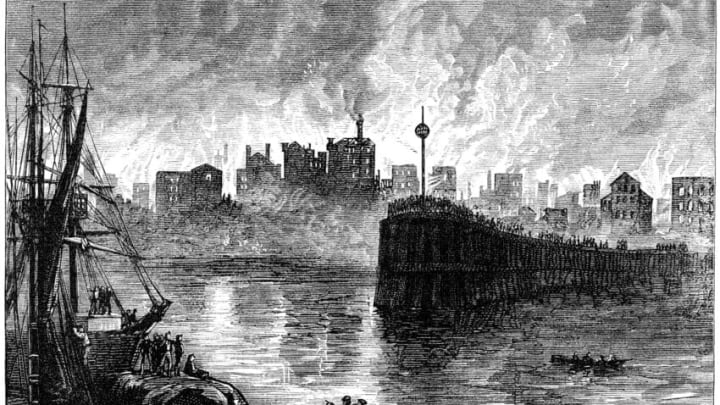It was 150 years ago this week when the Great Chicago Fire destroyed the heart of the city. Three square miles were completely destroyed, leaving about 31 percent of the population homeless. Chicago lost homes, big businesses and much of its infrastructure. It is hard to find someone who does not at least the basic story of the fire, but what some might not realize is that it played a role in Chicago Cubs history.
The Chicago Cubs in 1871, before the National League.
While the “official” history of the franchise begins in 1876 when the National League was founded, the team had existed since the 1860s. Prior to the National League, they were part of the old National Association, which started in 1871. Back then the team was known as the “White Stockings” (not to be confused with the White Sox today). They would not be known as “Cubs” until the early 1900s.
In the late-1860s and early-1870s, the White Stockings (who played different independent clubs prior to the National Association) bounced from several ballyards around the Chicagoland area until they settled on the lakefront in 1871, right off Michigan Avenue and Randolph Street near the industrial railroad yards. This is where Millennium Park is today. As they began their first season in the National Association, they christened Union Baseball Grounds (also known as Lakefront Park).
There is not a ton of information about the old Union Baseball Grounds, but there is some. What is known is that it was a box-shaped ballpark with wooden stands and a wooden fence. In 1871, American artist Theodore R. Davis created an aeriel view image of Chicago before the fire and the box-shaped ballpark and diamond can be seen on the lakefront just west of the converging railroad tracks. The diamond faced south/southeast, with home plate on the north/northwest end of the park and the first base line laying toward Michigan Avenue. The main grandstand area was in the northwest corner behind home plate. According to chicagology.com, the known dimensions of the park included both left and right field being 375 feet, with center field dimensions not known.
Jimmy Wood’s White Stockings played their season opener at the Union Baseball Grounds on May 8, 1871, defeating the Cleveland Forest Citys. Little did the team know that they would play their final home game at the Union Baseball Grounds on September 29 against the Boston Red Stockings before disaster would strike.
Chicago Cubs: The Great Chicago Fire of 1871
On the night of October 8, the Great Chicago Fire began in the barn of the O’Leary family on the southwest side of the city. As the fire raged through downtown, it approached the lakefront. The Union Baseball Grounds was right in the fire’s path. The wooden ballpark stood no chance against the inferno, and it was completely destroyed.
With no ballpark nor equipment, the White Stockings looked like they had lost it all. However thanks to the railroad’s funding efforts, the White Stockings were able to play the rest of their season on the road. They finished 19-9 in third place. It was a shame the team could not use their new ballpark for even one season before being destroyed. Worth noting that wooden ballparks of that era being destroyed or heavily damaged by fire was not very uncommon, but still.
It was not until 1874 when the White Stockings had a new permanent home. This new ballpark was built on 23rd and State streets, known as the 23rd Street Grounds. The White Stockings would play there through 1877, making the 23rd Street Grounds the Cubs first official home ballpark as a National League club. However, the story of the Union Baseball Grounds does not end there.
In 1878 the team was on the move yet again…back to the lakefront off Michigan Avenue and Randolph. Lakefront Park (2.0) was constructed on the same site where the old Union Baseball Grounds stood. This was a unique ballpark that could host around 10,000 spectators but had outfield dimensions of under 200 feet to both left and right field and only 300 feet to center. Until 1884, balls hit over the fence at Lakefront Park were ground-rule doubles because of the short dimensions.
Unfortunately for spectators, the combination of smells from different nearby industrial plants and blowing ash from the post-fire landfill along the lake did not always make the experience at the ballpark enjoyable. Fans did at least enjoy watching three straight NL champion White Stockings teams from 1880-1882.
While the Great Chicago Fire is remembered for many reasons, baseball is rarely one of them. Since the sport was in its infancy at the time, it was not nearly as popular as it would become in the following decades.
